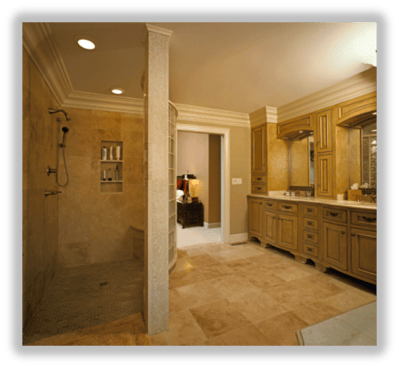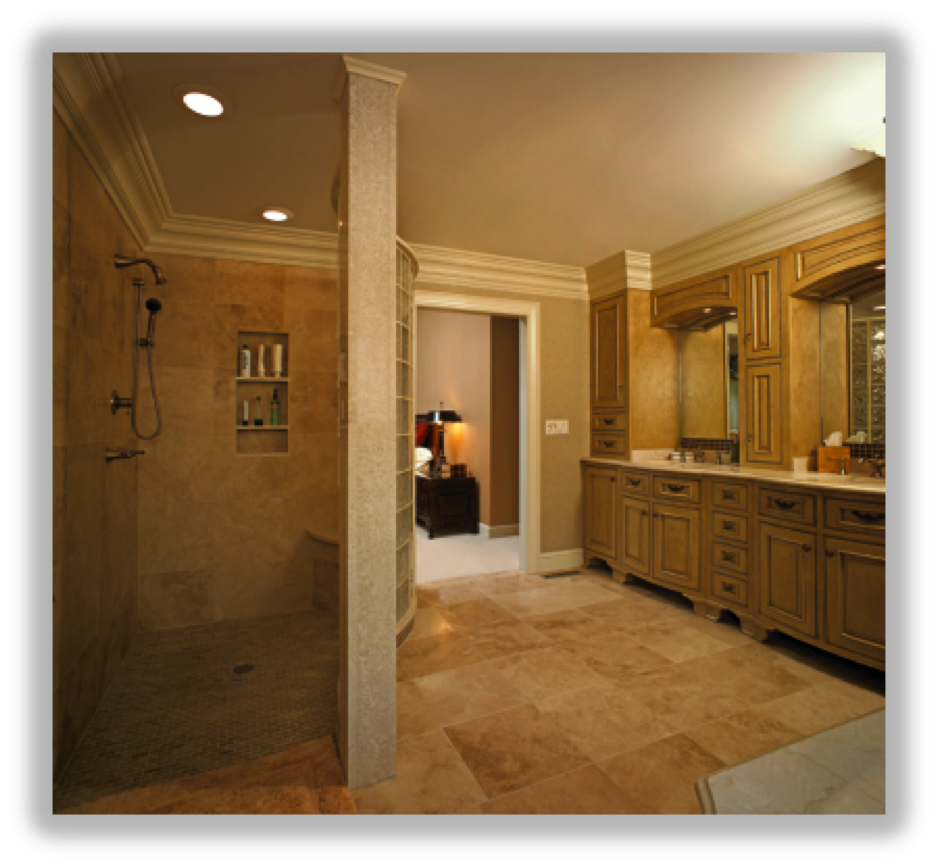Tile is essential in every bathroom. In a room where hygiene is important, tile is the perfect wall and floor surface because of its resistance to humidity and water and it is easy to clean.
1. Be Creative with Wall Tile
 When selecting wall tile for a bathroom, consider who will use the bathroom and how they will use the space. Tile selected for a children’s bathroom should be bright and easy to maintain - 4-by-4 inch ceramic tile might be the perfect choice. In a master suite spa, natural stone would set the mood. For a busy working couple with little time for cleaning the bathroom, subway tile would function well. For a small half guest bathroom, splurge a little and select a special tile.
When selecting wall tile for a bathroom, consider who will use the bathroom and how they will use the space. Tile selected for a children’s bathroom should be bright and easy to maintain - 4-by-4 inch ceramic tile might be the perfect choice. In a master suite spa, natural stone would set the mood. For a busy working couple with little time for cleaning the bathroom, subway tile would function well. For a small half guest bathroom, splurge a little and select a special tile.
The most common tile for bathrooms is 4” x 4” square ceramic tile. For years, homeowners have selected these tiles because of the range of colors, utility and price. However, today’s bathrooms are often designed with spa features or can be a room where people may select high-end tile because they have a small area to tile.
Another popular tile in both bathrooms and kitchens is 3” x 6” subway tile. In a small bathroom or shower, classic white subway tiles reflect light and create a feeling of space.
In a bathroom, fewer grout lines to clean is a plus. Grout in a 3” x 6” subway tile layout has about the same amount of grout lines as 4” x 4” tile. The real difference is seen when using bigger tiles such as 12” x 12”.
Tub and shower areas typically have three tiled walls, which can be a place to be creative with decorative tile design. Tub platforms and sink backsplashes are also places for decorative tile design.
Contemporary tile products gaining popularity are recycled glass tile and pebble tile.
2. Use Slip-resistant Floor Tile
Bathroom floors can be hazardous when wet. Look for slip-resistant tile when you select tile. Check the manufacturer’s product literature to determine if a tile is slip-resistant. Unglazed tile usually provides a good footing, as do many mosaics. Glazed tiles with texture, grit or a wavy profile can also provide adequate traction.
Give special consideration to the tile you select for a bathroom floor. There are many shapes textures, colors and tile products available. You may not want to put wood on a bathroom floor, but if you like the look there are now porcelain tiles made to replicate wood that come in 2-, 3- and 4-inch planks. Traditional bathrooms have used 1-inch octagon tile on floors because of durability and ease of maintenance.
3. Use Borders and Molding to Accentuate Wall and Floor Tile
A border is commonly used to break up long stretches of wall tile and give architectural definition to a room. Typically, a border tile is a narrow strip of tile. Borders can be dimensional or a contrasting color. They also can be formed by using more than one type of tile to create a strong expressive design. Border tile can be used to accentuate doors, mirrors, and sinks or form a chair rail. Since they have a visual appeal, they should be logical, coherent accents in the room.
Moldings ease the transition between surfaces in a bathroom where the tile meets the wall, floor or ceiling. Many homeowners use wood moldings around a shower or floor in a bathroom. About 90% of the bathrooms we remodel do use wood baseboard coving. If you’re concerned about rot and resilience, look for water resistant cove tile, a very durable option for floor coving.
4. Hire a Professional Installer
Shower and tub walls require careful water-proofing. It is important to use water-resistant drywall, also called “greenboard”, or a tile substrate made for wet areas like bathrooms. The seams between drywall boards should be sealed with fiberglass tape and spread with tile adhesive. Grout used around bathroom tiles should contain mildew resistive additives and be sealed to repel water. If you are using tile on a shower floor, a professional installer may need to custom craft the flooring to assure that water flows toward the drain and that the threshold does not create problems.


